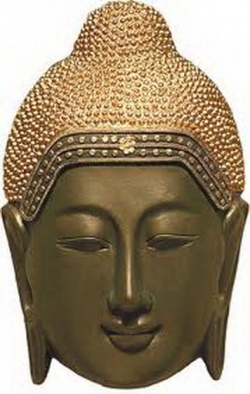Dharmakiirti's Theory of Inference: Revaluation and Reconstruction.
Rajendra Prasad, a retired professor of philosophy who has written on a wide range of topics in classical Indian thought, has turned his attention in this book to the inferential theory of one important Indian Buddhist philosopher, Dharmakiirti.
As Prasad points out in his preface, it has only been recently that philosophers writing about Indian philosophy have produced books investigating the work of a single author, rather than exploring an entire school, and even fewer books have been dedicated to extensive investigations of a single treatise by a single author (p. xiii).
It is his aim, therefore, "to present Dharmakiirti's logic as an individual logician's work per se, and not in relation to anyone else's nor as the logic of a school" (p. xiii).
Prasad almost delivers on this promise in that he dedicates his entire study to a single text by Dharmakiirti, namely, the Nyaayabindu; he does not quite escape the temptation to present the thought of a school, since he folds in a considerable amount of detail from Dharmottara's Nyaayabindu.tiikaa and Durveka Misra's Dharmottarapradiipa.
Prasad's reason for choosing to focus on this treatise, rather than one of Dharmakiirti's longer works, is that he finds the Nyaayabindu to be Dharmakiirti's most mature work on the theory of inference.
In justifying his use of the Nyaayabindu, Prasad writes: "Though none of his works can be described as philosophically weak, Nyaayabindu surpasses all the rest for conciseness, precision, systematic development and rigor, without a hint of opaqueness or unintelligibility" (p. 1).
It might be more accurate to say that Nyaayabindu, the most compendious of Dharmakiirti's writings, is written in such a terse style as to be almost impossible to interpret accurately without either looking carefully at the same author's longer works or making extensive use of later commentators who were familiar with the entire Dharmakiirti corpus.
Just the Nyaayabindu alone, stripped of any commentary, is no more than about two pages long. Dharmottara's commentary is 95 pages, and Durveka Misra's sub-commentary (including Dharmakiirti's root text and Dharmottara's commentary) is just under 260 pages. Without the help of Dharmottara and Durveka Misra, Dharmakiirti's Nyaayabindu would be an insignificant text, the philosophical weakness of which was concealed by its almost perfect opaqueness and unintelligibility. It is not an obvious candidate for the text one would choose to represent Dharmakiirti at his best.
The Nyaayabindu contains three chapters, of which Prasad studies two.
Prasad's study is presented in fifteen chapters, the titles of which accurately reflect their contents: "Knowledge and Human Ends," "Division of Inference into Inference for Oneself and Inference for Someone Else," "Inference for Oneself," "Non-cognition as Logical Reason," "Forms of Inference Using Non-cognition as Logical Reason," "Identity as Logical Reason," "Effect as Logical Reason," "Some Problems in Proving the Completeness of Dharmakiirti's Theory of Inference,"
"Inference for Someone Else," "The Role of Example," "Inference for Someone Else and Aristotelian Syllogism," "Inference for Someone Else and the Deductive-Inductive Distinction," "Impermissible Inferences," "Concluding Overview."
The table of contents, which is twenty-five pages long, offers a fairly detailed abstract of the contents of each chapter and of each section and subsection of each chapter and makes finding the exact location of particular discussions easy.
The detailed table of contents thus complements the short but useful index.
The select bibliography is helpful and would be more so if it did not contain many minor errors (such as dates of publications, page numbers and typographical blunders in titles of books and articles) and a few major ones (such as listing B. J. Georges, rather than Georges B. J. Dreyfus, as the author of Recognizing Reality: Dharmakiirti's Philosophy and Its Tibetan Interpreters [1997]).
It is not obvious who the intended audience of Prasad's work is.
It is clear that it is not aimed at scholars of Buddhism who are interested in exploring how (or even whether) skill in inference plays a significant role in the pursuit of nirvana or enlightenment; Prasad makes it clear that he is interested only in Dharmakiirti's logic, not his Buddhism.
It is probably safe to say also that Prasad was not writing for the growing number of scholars who have been specializing in the study of Dharmakiirti during the past thirty or forty years.
Only a few of these scholars are cited in the bibliography, and of them it is their older work that is cited.
Prasad's text itself has no discussion of the contributions by Ernst Steinkellner, Claus Oetke, Shoryu Katsura or Tom T. F. Tillemans to our understanding of the structure of Dharmakiirti's theory of inference.
The scholars whose contributions Prasad does discuss are the pioneer scholars (Stcherbatsky, Keith, Dasgupta, Hiriyanna and Vidyabhushana) who wrote in the early decades of the twentieth century.
While he rightly shows that these pioneers in the modern study of Indian logic often made misleading presentations, Prasad does not mention that their mistakes have been well known for the past thirty years or so and that the field has moved on to considerably more authoritative presentations.
Particularly unfortunate is Prasad's neglect of Tillemans and Oetke, both of whom have managed to clear away a good many of the misconceptions that earlier scholars had about the nature of the logical sign (hetu, linga) and the relationship between reasoning for oneself (svaartha-anumaana) and demonstrating to others (paraartha-anumaana) what one has learned through one's own reasoning.
What a number of Dharmakiirti specialists are now saying rather clearly, Prasad is still saying relatively awkwardly and murkily.
An example of a confusion that runs throughout Prasad's book is the following claim in his conclusion. "Knowledge, for Dharmakiirti, is cognition which is veridical and informative in the sense that it is a true cognition of a hitherto unknown thing or state of affairs" (p. 237).
If Prasad's claim were true, then it would follow that Dharmakiirti would not be able to say, for example, that my belief (or cognition) that Devadatta was the Buddha's cousin is an instance of knowledge. It would not qualify as knowledge because my cognition about Devadatta is not about a hitherto unknown state of affairs.
Indeed, it is my belief precisely because I have been informed about what has been known for quite some time. Fortunately, Dharmakiirti does not leave himself open to such a serious mistake.
What he does say--although in the Pramaa.navaarttika rather than in the Nyaayabindu--is that a pramaa.na is a cognition that does not lead one astray and that presents something new.
(There has been a considerable amount of discussion among Dharmakiirti specialists whether he intended to say that a pramaa.na must present new knowledge or that whatever does present new knowledge may be considered a pramaa.na.
The matter is not as straightforward as Prasad seems to think.)
On one reading of the Pramaa.navaarttika, then, a pramaa.na, is for Dharmakiirti not knowledge itself, but rather the discovery of new knowledge. Prasad's claim about Dharmakiirti would be accurate if the word "discovery" or the phrase "a source of new knowledge" were used in place of the word "knowledge." Greater care in reporting what Dharmakiirti actually said would have saved Prasad the effort of showing the absurd implications of some of the claims that he falsely reports Dharmakiirti to have made.
Let me give an example of a discussion that ensues from this muddle about Dharmakiirti's definition of pramaa.na.
In his discussion of "identity as logical reason" (svabhaava-hetu), Prasad makes the claim that such an inference cannot provide knowledge, because it presents no new information.
The kind of inference in question is one that in English could be rendered as follows: "This is a tree, because it is an Ashoka tree."
Inference, says Prasad, is supposed to provide one with more knowledge than one previously had.
But, he says, if we already know that something is an Ashoka tree, then the conclusion that it is a tree contains less information than the premise, "this is an Ashoka tree," from which the conclusion was derived.
Arriving at a conclusion that contains less information than the cognition that led to the conclusion hardly qualifies as learning something new, and therefore an inference using identity as a logical reason is not really knowledge (as Prasad claims that Dharmakiirti defines knowledge).
Since inference is knowledge, an inference using identity as a logical reason is not really an inference at all, says Prasad, for if it were, it would be knowledge (pp. 92-4).
There are, to be sure, some puzzles in Dharmakiirti's doctrine of svabhaava-hetu, but the conundrum that Prasad presents is not among them.
There is, of course, a sense in which it is true that an inference using a svabhaava-hetu yields a conclusion that contains no information that is not already contained in its premises, but that is true of any deductive inference, not just one using a svabhaava-hetu.
Incidentally, if we know that Dharmakiirti did regard an inference using a svabhaava-hetu as an instance of pramaa.na, and if we give him credit for realizing that no deductive inference yields new knowledge, this might give us reason to rule as inaccurate Prasad's claim that Dharmakiirti defines a pramaa.na as a cognition that yields knowledge not hitherto known.
A more charitable reading of Dharmakiirti would have him defining a pramaa.na as a cognition that, when acted upon, does not lead to unexpected results and then adding that anything that adds to our knowledge is, for all practical purposes, like a pramaa.na.
When we recall that this entire discussion of how to define pramaa.na in general takes place in a chapter of the Pramaa.navaarttika dedicated to proving that the Buddha is a pramaa.na (or at least a virtual pramaa.na), we can better understand the religious motivation for adding this qualifying phrase about novelty. In the Nyaayabindu, where the religious themes are muted, the general definition of pramaa.na has no mention of the novelty of knowledge.
Although, as noted above, Prasad's study is unlikely to be considered a significant contribution to a specialist's understanding of Dharmakiirti, it may be of some use to students of comparative philosophy who are interested (as such pioneers as Stcherbatsky, Keith, Dasgupta et al were) in assessing what the limitations are in applying the terminology of classical and modern Western logic to Dharmakiirti, or any other Indian thinker.
Can one describe what Dharmakiirti does as logic? If so, can the systematic presentation of an inference using his schema be called a syllogism?
If so, does Dharmakiirti describe the syllogism as clearly and with as much acumen as Aristotle did?
Is there anything to be gained by trying to describe Dharmakiirti's theory of inference in terms of set theory or Boolean algebra or quantificational logic?
If what Dharmakiirti presents is logic, does it make sense to characterize it as deductive logic or inductive logic or some combination thereof, or is it an entirely different kind of logic?
Questions such as these about Indian logic as a whole have already been discussed at some length by A. B. Keith and more recently by I. M. Bochenski and J. F. Staal. What might be interesting would be a careful analysis of how well what they say of Indian logic as a whole applies to Dharmakiirti in particular.
There is, however, no discussion in this book of either Bochenski or Staal, although both are mentioned in Prasad's Select Bibliography.
In summary, I find it difficult to recommend Prasad's work to people interested in the role of reasoning in Indian Buddhist scholasticism, to specialists in Dharmakiirti, or to students of comparative philosophy.
It is, however, quite possible that the book will serve the useful purpose of firing up someone's interest in Dharmakiirti's theory of inference enough to incite that person to write a more accurate and challenging monograph on the topic.


